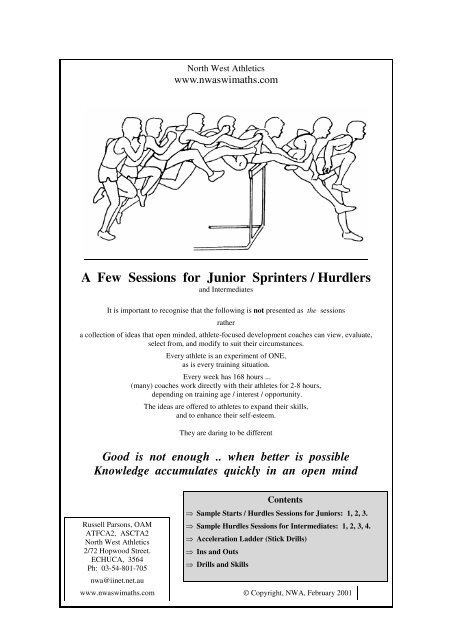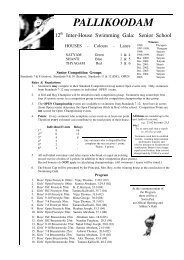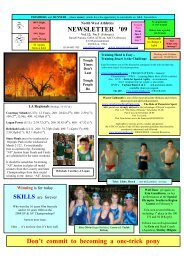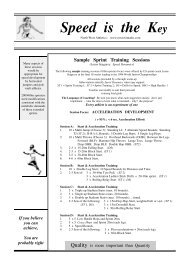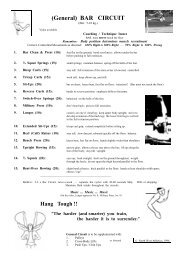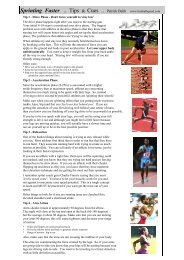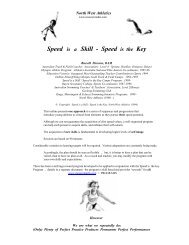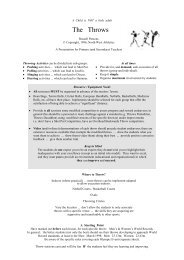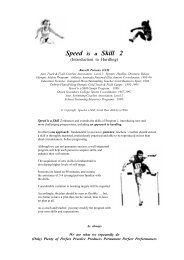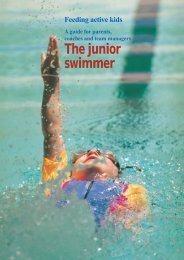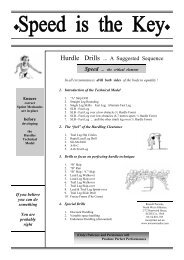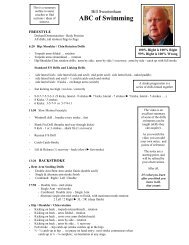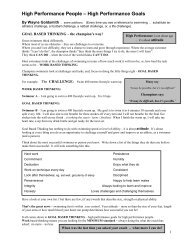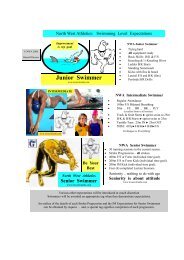Hurdles Sessions.pub - North West Athletics
Hurdles Sessions.pub - North West Athletics
Hurdles Sessions.pub - North West Athletics
Create successful ePaper yourself
Turn your PDF publications into a flip-book with our unique Google optimized e-Paper software.
<strong>North</strong> <strong>West</strong> <strong>Athletics</strong><br />
www.nwaswimaths.com<br />
A Few <strong>Sessions</strong> for Junior Sprinters / Hurdlers<br />
and Intermediates<br />
It is important to recognise that the following is not presented as the sessions<br />
rather<br />
a collection of ideas that open minded, athlete-focused development coaches can view, evaluate,<br />
select from, and modify to suit their circumstances.<br />
Every athlete is an experiment of ONE,<br />
as is every training situation.<br />
Every week has 168 hours ...<br />
(many) coaches work directly with their athletes for 2-8 hours,<br />
depending on training age / interest / opportunity.<br />
The ideas are offered to athletes to expand their skills,<br />
and to enhance their self-esteem.<br />
They are daring to be different<br />
Good is not enough .. when better is possible<br />
Knowledge accumulates quickly in an open mind<br />
Russell Parsons, OAM<br />
ATFCA2, ASCTA2<br />
<strong>North</strong> <strong>West</strong> <strong>Athletics</strong><br />
2/72 Hopwood Street.<br />
ECHUCA, 3564<br />
Ph: 03-54-801-705<br />
nwa@iinet.net.au<br />
www.nwaswimaths.com<br />
Contents<br />
⇒ Sample Starts / <strong>Hurdles</strong> <strong>Sessions</strong> for Juniors: 1, 2, 3.<br />
⇒ Sample <strong>Hurdles</strong> <strong>Sessions</strong> for Intermediates: 1, 2, 3, 4.<br />
⇒ Acceleration Ladder (Stick Drills)<br />
⇒ Ins and Outs<br />
⇒ Drills and Skills<br />
© Copyright, NWA, February 2001
www.nwaswimaths.com<br />
Thoughts<br />
<strong>North</strong> <strong>West</strong><br />
<strong>Athletics</strong><br />
• In my view, the term “junior coach” has negative connotations.<br />
♦<br />
If there is to be a label “Development Coach” comes closer to reality.<br />
Bill Sweetenham, a world leader in the coaching of swimmers comments: “Few swimmers make<br />
significant changes to their technique after reaching their mid-teens.”<br />
Is track and field so different? Having had extensive experience in both sports, I would suggest the<br />
statement has a degree of validity .. sure there are exceptions, but let’s look at the bigger picture.<br />
So what’s the message .. more of a question actually: Should young athletes have the best<br />
coaches, or, should the best be used to serve the needs of the emerging elite?<br />
My answer: Athletes should have the coach best suited (most appropriate) to their needs (their<br />
stage of physical and mental experience).<br />
I would seriously doubt my capacity and commitment to refine a 1:47.00 800m runner to the elite<br />
levels of 1:43.00 and beyond; I am not interested in such singular focus, important though it is.<br />
While some mope around complaining about why athletes don’t come to them, I’m<br />
active every day, with wonderful groups of swimmers and runners, whose interests lie far beyond<br />
the narrow confines of achievement in one area. (If you want a copy of our Newsletter, just ask; I am<br />
eager to attract new ideas .. I am happy to share ideas.)<br />
I’m a Development Coach .. my role is to work with youngsters, teach well the fundamental skills<br />
of athletics (especially sprinting, hurdling, middle distance) enhance self-esteem in young people,<br />
share experiences, and enjoy the almost unlimited opportunities for satisfaction associated<br />
with working with minds eager to learn new skills and have their efforts recognised.<br />
The ever-changing structure I have developed over 35 years attempts to achieve this.<br />
Too many assume that every child wants to be an Olympic Champion .. or, is it too many coaches<br />
see themselves as an Olympic Coach?<br />
There are lots of things to do in life.<br />
For most, athletic ability and sporting “potential” (a measure of what we are yet to achieve), is but a<br />
passing phase. Experienced development coaches recognise this, and aim to enhance generic and<br />
specific movement capabilities, thereby enhancing the range of options available to each emerging<br />
adult.<br />
<strong>Athletics</strong>, however, is uniquely placed in the sporting kaleidoscope.<br />
Our major pre-occupation is with speed .. performing tasks as quickly as possible, whether it be<br />
sprinting 100 metres, running a marathon or putting the shot.<br />
Because of this acknowledged focus, skills developed through athletics have an application in<br />
almost all sporting contexts ….. speed is a skill. And, all athletes need (seek) speed.<br />
• So, athletics must expand out .. encourage other sports to join in .. take from other sports the<br />
benefits or skills they better develop .. and, show leadership in not demanding allegiance, but<br />
offering benefits that will help all. The result could be an enhanced level of respect for athletics.<br />
Young minds want to explore and learn new ideas / skills .. It’s all about how each parent/coach/<br />
athlete communicates … what they have to offer.<br />
When the mind is stretched by a new idea,<br />
it never returns to its former dimensions<br />
• The practices that are currently applied, have landed us in the sport’s current position. Of course,<br />
there are many good ideas, often seldom applied effectively beyond the scope of specific coaching<br />
groups.<br />
And, while I strongly support the need for centralised policy and consistency, every area, every<br />
group, every place, is an experiment of one. Each area must develop practices that specifically<br />
satisfy the needs of that area … change is inevitable, and if we don’t change, if we don’t<br />
experiment, if we automatically dismiss and refuse to try new ideas … we’ll get (at best) what we<br />
we currently have …. is that good enough?<br />
Knowledge (only) accumulates quickly<br />
in<br />
an open mind
© NWA, 2001<br />
Sample Starts / <strong>Hurdles</strong> Session for Juniors (1)<br />
Introduce one new stretch each session<br />
1. WARM-UP: Jog, Stretch, Drills, Accelerations;<br />
— then, Speed and Hurdle Specific Drills (10 mins.)<br />
2. STARTS: Standing Starts to 20m / 30m … emphasis on stable “Set” position,<br />
with correct knee, foot, arm alignments (3-4; complete recoveries)<br />
3-Point Starts (from standing) … (2-3; complete recoveries)<br />
Acceleration Ladder (Stick Drill) … max. efforts to 15 / 20m;<br />
alternating lead foot … extra practice of preferred hurdles start foot<br />
position; standing starts; (4-6; complete recoveries)<br />
10/40 15/50<br />
Start Start<br />
.40 .50<br />
.90 1.15<br />
1.50 1.95<br />
2.20 2.90<br />
3.00 4.00<br />
3.90 5.25<br />
- 10 - - 10 -<br />
- 15 - - 15 -<br />
Whistle, Clap and “Gun” starts.<br />
3. Hurdle Drills … sneakers on<br />
(15 mins.)<br />
100% Right is 100% Right<br />
99% Right is 100% Wrong<br />
3.1 Command Drills: A-Skip; Alternating Butt Kicks;<br />
Combinations; A & C; B-Skip; A-B-C; A-B-Trail Leg.<br />
3.2 Marching Stepovers .. start sequence with non-preferred<br />
lead leg; why? 6 <strong>Hurdles</strong> .. Variations<br />
3.3 Single Step-Overs .. start sequence with non-preferred<br />
lead leg; why? 6 <strong>Hurdles</strong> .. timed comparisons .. preferred /<br />
non-preferred lead leg.<br />
3.4 HURDLE COMBINATIONS: spikes on<br />
6 Marching Step-Overs (non-preferred lead leg, 3 steps b/t) → A-Skip → 6 Single Step-Overs<br />
(Max. speed) → A-Skip → 6 Marching Step-Overs (preferred lead leg, 3 steps b/t).<br />
Repeat(s): starting with preferred lead leg. (25 mins.)<br />
Ensure that drills are applied with equal attention to detail on both sides of the body<br />
When in doubt .. do extra / more on the non-preferred side<br />
4. STARTS to H1: the importance of speed to and off H1<br />
3-4 Starts to H1 → finish at 20m; “Gun” starts … 3-4 repeats; complete recoveries.<br />
(10 mins.)<br />
5. Review / Warm Down .. incl. variations, e.g. under & overs (10 mins.)<br />
<strong>North</strong> <strong>West</strong><br />
<strong>Athletics</strong><br />
Resources:<br />
2 or 3 x 18 hurdles (assuming 2-3 lanes operating); tape measure; masking tape (sticks);<br />
stop watch(es), whistle, gun / caps; video cameras, batteries, cassettes; full water bottle(s); hat; slip-slop-slap.<br />
One new stretch / one new drill each session<br />
Do NOT prioritise skill/drill progression ahead of skill acquisition<br />
Video taping of athlete efforts (drills, starts, hurdles .. front / side / back)<br />
Times assigned to segments are approximate.<br />
Only<br />
Plenty of Perfect Practice<br />
Produces<br />
Professional<br />
Performance(s)<br />
www.nwaswimaths.com
© NWA, 2001<br />
Sample Starts / <strong>Hurdles</strong> Session for Juniors (2)<br />
Introduce one new stretch each session<br />
1. WARM-UP: Jog, Stretch, Drills, Accelerations;<br />
— then, Speed and Hurdle Specific Drills (10 mins.)<br />
2. STARTS: Standing Starts to 20m / 30m … emphasis on stable “Set” position,<br />
with correct knee, foot, arm alignments (3-4; complete recoveries)<br />
3-Point Starts (from standing) … (2-3; complete recoveries)<br />
Acceleration Ladder (Stick Drill) … max. efforts to 15 / 20m;<br />
alternating lead foot … extra practice of preferred hurdles start foot<br />
position; standing starts; (4-6; complete recoveries)<br />
10/40 15/50<br />
Whistle, Clap and “Gun” starts.<br />
(15 mins.)<br />
Start Start<br />
.40 .50<br />
.90 1.15<br />
1.50 1.95<br />
2.20 2.90<br />
3.00 4.00<br />
3.90 5.25<br />
- 10 - - 10 -<br />
- 15 - - 15 -<br />
3. Hurdle Drills … sneakers on<br />
3.1 Command Drills: A-Skip; Alternating Butt Kicks;<br />
Combinations; A & C; B-Skip; A-B-C; A-B-Trail Leg, SLB.<br />
3.2 Marching Stepovers .. start sequence with non-preferred<br />
lead leg; why? 6 <strong>Hurdles</strong> .. Variations<br />
3.3 Single Step-Overs .. start sequence with non-preferred<br />
lead leg; why? 6 <strong>Hurdles</strong> .. timed comparisons .. preferred /<br />
non-preferred lead leg.<br />
3.4 HURDLE COMBINATIONS: spikes on<br />
6 Marching Step-Overs (non-preferred lead leg, 3 steps b/t) → A-Skip → 6 Single Step-Overs<br />
(Max. speed) → A-Skip → 6 Marching Step-Overs (preferred lead leg, 3 steps b/t).<br />
Repeat(s): starting with preferred lead leg. (25 mins.)<br />
Ensure that drills are applied with equal attention to detail on both sides of the body<br />
When in doubt .. do extra / more on the non-preferred side<br />
4. STARTS to H1 – H2 – H3: the importance of speed to and off H1<br />
2 Starts to H1 → finish at 20m and 30m; “Gun” starts … complete recoveries;<br />
2 starts to H2<br />
1-2 starts to H3 (20 mins.)<br />
5. Review / Warm Down .. incl. variations, e.g. under & overs (10 mins.)<br />
Resources: 2 or 3 x 18 hurdles (assuming 2-3 lanes operating); tape measure; masking tape (sticks);<br />
stop watch(es), whistle, gun and caps; video cameras, cassettes; full water bottle(s); hat; slip-slop-slap.<br />
<strong>North</strong> <strong>West</strong><br />
<strong>Athletics</strong><br />
One new stretch / one new drill each session<br />
Do NOT prioritise skill/drill progression ahead of skill acquisition<br />
Video taping of athlete efforts (drills, starts, hurdles .. front / side / back)<br />
Times assigned to segments are approximate.<br />
Only<br />
Plenty of Perfect Practice<br />
Produces<br />
Professional<br />
Performance(s)<br />
www.nwaswimaths.com
© NWA, 2001<br />
Sample Starts / <strong>Hurdles</strong> Session for Intermediates (1)<br />
Introduce one new stretch each session<br />
1. WARM-UP: Jog, Stretch, Drills, Accelerations;<br />
— then, .. Hurdle Specific Drills (10 mins.)<br />
2. STARTS: Standing Starts to 20m / 30m … emphasis on stable “Set” position,<br />
with correct knee, foot, arm alignments (2-3; complete recoveries)<br />
3-Point Starts (from standing) … (3-4; complete recoveries)<br />
10/40 15/50<br />
Start Start<br />
.40 .50<br />
.90 1.15<br />
1.50 1.95<br />
2.20 2.90<br />
3.00 4.00<br />
3.90 5.25<br />
- 10 - - 10 -<br />
- 15 - - 15 -<br />
Acceleration Ladder (Stick Drill) … max. efforts to 15 / 20m;<br />
alternating lead foot … extra practice of preferred hurdles start foot<br />
position; standing starts; (4-6; complete recoveries) (10 mins.)<br />
Whistle, Clap and “Gun” starts.<br />
3. Hurdle Drills … sneakers on<br />
3.1 Command Drills: A-Skip; Alternating Butt Kicks;<br />
Combinations; A & C; B-Skip; A-B-C; A-B-Trail Leg; SLB;<br />
SLB-Fast Leg.<br />
3.2 Marching Stepovers .. start sequence with non-preferred<br />
lead leg; why? 6 <strong>Hurdles</strong> .. variations: heights / lead leg<br />
3.3 Single Step-Overs .. start sequence with non-preferred lead leg;<br />
why? 6 hurdles .. timed comparisons .. preferred /non-preferred<br />
lead leg.<br />
Slo Mo ???<br />
Achievement Certificate available<br />
Juniors & Intermediates<br />
work together on 1-3;<br />
thereafter,<br />
Intermediates spend more time<br />
on specifics<br />
(15 mins.)<br />
Ensure that drills are applied with equal attention to detail on both sides of the body<br />
When in doubt .. do extra / more on the non-preferred side<br />
4. STARTS to H1 – H2: the importance<br />
2 Starts to H1 → finish at 20m and 30m; “Gun” starts … complete recoveries;<br />
2 starts to H2<br />
2 x 5 stepping between 4H .. rolling start; walk back recoveries +1-2 mins.<br />
Rolling start ► 2-4 x 4H (7m separation) and return .. left leg lead / right leg lead .. Variations<br />
<strong>North</strong> <strong>West</strong><br />
<strong>Athletics</strong><br />
│ ║ 7 ║ 7 ║ 7 ║ │<br />
│ ║ 7 ║ 7 ║ 7 ║ │<br />
Start/Finish<br />
Start/Finish<br />
(20-30 mins.)<br />
5. Review / Warm Down .. incl. variations, e.g. unders & overs, hurdle relays, … (10 mins.)<br />
One new stretch / one new drill each session .. do not prioritise skill/drill progression ahead of skill acquisition<br />
Precision - Patience - Variation<br />
Good is not enough …. where BETTER is possible<br />
www.nwaswimaths.com
© NWA, 2001<br />
Sample <strong>Hurdles</strong> Session for Intermediates (2)<br />
Introduce one new stretch each session, and later, one new drill each session<br />
1. WARM-UP: Jog, Stretch, Drills, Accelerations;<br />
— then, (sneakers) .. Hurdle Specific Drills, incl. Trail Leg Hips Circles, Wall Attack, Slo Mo. (10 mins.)<br />
2. Hurdle Drill variations .. Spikes on?<br />
Start with: Marching Stepovers .. start sequence with nonpreferred<br />
lead leg; why? 6 <strong>Hurdles</strong>: variations: heights / lead leg<br />
then, Single Step-Overs .. start sequence with non-preferred<br />
lead leg; why? 6 hurdles .. timed comparisons .. preferred /<br />
non-preferred lead leg.<br />
then, Laterals (Anisimova) .. stress balance and co-ordination;<br />
Athlete = supporter of which AFL team?<br />
develop and maintain a rhythm. (and /or, Calvesi and /or Karate Kid Kicks .. separate sheets) (15 mins.)<br />
Laterals<br />
3. Rhythm Runs .. Ins & Outs (sneakers .. ∆ to spikes after 1st rep.)<br />
• 3-5 x 50m .. 3-point starts; w/b +1 min. recovery<br />
(Stress: Relaxation at speed; watch foot strike; posture)<br />
• Introduce Ins and Outs (separate sheet) .. 2-4 practice runs off 3-point starts<br />
4. Strength: athletes must have sneakers for Bounds (no exceptions)<br />
4.1 Bounds: max. of 50 contacts<br />
5 <strong>Hurdles</strong>: 2 x 5 Pre-Jump; 4 x 5 Explosive; 2 x 5 Pre-Jump<br />
2 x 5 Bound .. Stick the landing (Coach commands)<br />
Ensure adequate recovery between sets: a stretch?? (e.g. 1 or 2, below)<br />
4.2 4 x 6 Sand Hops (bare feet)<br />
(work both legs; start with non-preferred side;<br />
i.e. 6 Right ► 6 Left (rest 60-90 seconds, repeat x 4)<br />
(20 mins.)<br />
(15 mins.)<br />
5. Review / Warm Down<br />
3 x 70m .. walk-back (in sneakers)<br />
Easy Jog (choice) … static stretches (12 mins.)<br />
<strong>North</strong> <strong>West</strong><br />
<strong>Athletics</strong><br />
How should execution<br />
of warm-up and warm<br />
down differ? Why?<br />
It is better to have<br />
perfect technique at a lower height<br />
rather than<br />
poor technique at racing height<br />
Brent McFarlane (The Science of Hurdling & Speed)<br />
1<br />
2<br />
A few ideas<br />
www.nwaswimaths.com<br />
Strategies are (should be) cumulative<br />
Don’t do something once, then discard .. Practice & Refine your skills<br />
Only Plenty of Perfect Practice Produces Perfect Performances<br />
We are what we repeatedly do - work towards making Excellence YOUR habit<br />
Hold 30<br />
seconds<br />
x 3<br />
both<br />
sides<br />
3
© NWA, 2001<br />
Sample <strong>Hurdles</strong> Session for Intermediates (3)<br />
Introduce one new stretch each session<br />
1. WARM-UP: Jog, Stretch, Drills, Accelerations;<br />
— then (sneakers) .. Hurdle Specific Drills<br />
incl. Trail Leg Hips Circles, Wall Attack, Slo Mo, A-B-TL<br />
Start with: Marching Stepovers .. start sequence with non-preferred lead leg; why?<br />
6 <strong>Hurdles</strong>: variations: heights / lead leg<br />
then, Single Step-Overs .. start sequence with non-preferred lead leg; why?<br />
then, Laterals (Anisimova) .. stress balance and co-ordination; develop and maintain a rhythm.<br />
(and /or, Calvesi and /or Karate Kid Kicks .. separate sheets)<br />
(15 mins.)<br />
Laterals<br />
2. Hurdle Specifics: take the time to set-up all required<br />
resources before the commencement of the session<br />
2.1 4-5 x 3 pt. starts to 25m … rolling (1), 3 pt. (2) and block starts (2).<br />
2.2 4 x Acceleration Ladder … different athletes will have different spacings.<br />
2.3 4 x Hurdle Turnarounds: 3-4 hurdles .. 3 steps b/t<br />
| 12m ╣ 7m ╣ 7m ╣ 12m |<br />
Cone<br />
Start/Finish<br />
| 12m ╠ 7m ╠ 7m ╠ 12m |<br />
Cone<br />
Start/Finish<br />
Individual Runs,<br />
and<br />
Team<br />
Competitions<br />
2.4 4 x 5 Stepping between hurdles .. 3 – 4 <strong>Hurdles</strong><br />
| 12m ╣ 7m ╣ 7m ╣ 7m ╣ approx. 10m |<br />
Start<br />
Hurdle Turnarounds: Down & Back Preferred / Non– Preferred; Down Non-Preferred / Back Preferred; …<br />
2.5 2 x H4 … Gun Starts .. 12m run-out; maximum efforts; complete recoveries.<br />
(45 mins.)<br />
3. Review / Warm Down<br />
3 x 70m .. walk-back (in sneakers) (15 mins.)<br />
Easy Jog (choice) … static stretches<br />
Finish<br />
Walk back recovery<br />
+1-2 mins. review<br />
Hurdle spacing varied<br />
to ensure fast,<br />
snappy strides.<br />
The range of variations, drills, activities is<br />
almost endless, but, persist patiently;<br />
introduce new challenges gradually.<br />
<strong>North</strong> <strong>West</strong><br />
<strong>Athletics</strong><br />
Today is the Tomorrow YOU created Yesterday


